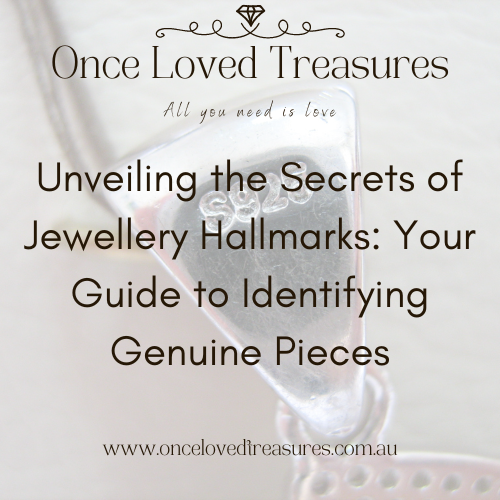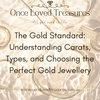
Unveiling the Secrets of Jewellery Hallmarks: Your Guide to Identifying Genuine Pieces
Unveiling the Secrets of Jewellery Hallmarks: Your Guide to Identifying Genuine Pieces
Welcome to Once Loved Treasures, where we celebrate the timeless allure of exquisite jewellery. Whether you're an avid collector or just beginning your journey into the world of fine jewellery, understanding hallmarks is essential. These small but significant marks can reveal a wealth of information about a piece’s authenticity, origin, and quality. In this comprehensive guide, we’ll explore the hallmarks of jewellery, how to identify them, what they mean, and how to make educated choices when selecting your next treasured piece.
The Importance of Jewellery Hallmarks
What Are Hallmarks?
Hallmarks are official marks or stamps placed on jewellery and other precious metal items to certify their purity, origin, and sometimes the date of manufacture. These marks serve as a guarantee of quality and authenticity, helping buyers make informed decisions.
Why Are Hallmarks Important?
- Authenticity Verification: Hallmarks verify the authenticity of a piece, ensuring it meets specific standards.
- Value Assurance: Hallmarked jewellery retains its value better due to the verified purity and quality.
- Consumer Protection: Hallmarks protect consumers from fraud by providing information about the metal content and origin.
Identifying Jewellery Hallmarks
Where to Find Hallmarks
Hallmarks are typically found in inconspicuous places on jewellery, such as:
- Inside Rings: Look on the inner band.
- Clasp of Necklaces and Bracelets: Check the clasp area for stamps.
- Back of Earrings: Examine the back side or the post.
- Underside of Brooches and Pendants: Inspect the underside or back for markings.
Common Hallmark Symbols
Understanding the common symbols found in hallmarks can help you decipher their meaning:
- Metal Purity Marks: Indicate the purity of the metal, often in parts per thousand. For example, "925" denotes sterling silver, which is 92.5% pure silver.
- Assay Office Marks: Identify the location where the metal was tested and hallmarked.
- Maker’s Marks: Represent the jeweller or company that manufactured the piece.
- Date Letters: Indicate the year the piece was hallmarked, often represented by a letter or symbol that changes annually.
Interpreting Hallmarks
Gold Hallmarks
Gold jewellery hallmarks vary by country but generally include:
- Purity Mark: Common marks include 375 (9 carat), 585 (14 carat), 750 (18 carat), and 916 (22 carat).
- Assay Office Mark: A symbol indicating the assay office, such as a leopard’s head for London or an anchor for Birmingham.
- Maker’s Mark: A unique mark identifying the jeweller.
Silver Hallmarks
Silver hallmarks typically include:
- Purity Mark: 925 for sterling silver, 800 for European silver.
- Assay Office Mark: Symbol indicating the assay office.
- Maker’s Mark: Identifying the manufacturer.
Platinum Hallmarks
Platinum hallmarks often include:
- Purity Mark: Common marks include 850, 900, 950, and 999, indicating the parts per thousand of pure platinum.
- Assay Office Mark: Symbol indicating the assay office.
- Maker’s Mark: Identifying the jeweller.
Ensuring Hallmarks Are Genuine
Authenticity Checks
To ensure the hallmarks on a piece of jewellery are genuine:
- Examine Under Magnification: Use a loupe or magnifying glass to inspect the hallmarks closely. Genuine hallmarks are usually crisp and clear.
- Compare to Reference Guides: Use reputable reference guides or online databases to compare the hallmarks you find with known genuine marks.
- Seek Professional Appraisal: If in doubt, have the piece appraised by a certified jeweller or gemologist.
Common Red Flags
Be wary of the following signs that may indicate fake or misleading hallmarks:
- Blurry or Fuzzy Marks: Genuine hallmarks are typically sharp and well-defined.
- Inconsistent Marks: Ensure all hallmarks on the piece are consistent with each other.
- Misspelled or Incorrect Marks: Incorrectly spelled or wrongly formatted hallmarks are a red flag.
Making Educated Choices When Choosing Jewellery
Research the Seller
Before purchasing jewellery, especially from online auction sites or new sellers, conduct thorough research:
- Check Reviews and Ratings: Look for customer reviews and ratings on platforms like Trustpilot or Google Reviews.
- Verify Credentials: Ensure the seller is accredited by reputable organisations such as the National Association of Jewellers or similar bodies.
Understand the Item Description
A detailed item description is crucial for making an informed purchase:
- Material and Purity: Ensure the description clearly states the metal type and purity.
- Gemstone Details: Look for detailed information about any gemstones, including carat weight, cut, clarity, and colour.
- Condition Report: Review the condition report to understand any wear, repairs, or alterations.
Ask Questions
Don’t hesitate to ask the seller questions to clarify any doubts:
- Can You Provide Additional Photos?: Request close-up images of the hallmarks and any significant features.
- Is There a Certificate of Authenticity?: Ask if the piece comes with a certificate from a reputable gemological laboratory.
- What Is Your Return Policy?: Ensure you understand the return policy in case the item does not meet your expectations.
Checklist for Buying Hallmarked Jewellery
Use this checklist to guide your purchase of hallmarked jewellery:
-
Verify the Hallmarks:
- Check the purity mark, assay office mark, maker’s mark, and date letter.
- Use a magnifying glass or loupe to inspect the marks closely.
- Compare the marks to reputable reference guides or databases.
-
Research the Seller:
- Look for customer reviews and ratings.
- Verify the seller’s credentials and accreditation.
-
Understand the Item Description:
- Confirm the metal type and purity.
- Review details about any gemstones.
- Check the condition report for wear or repairs.
-
Ask Questions:
- Request additional photos if needed.
- Ask for a certificate of authenticity.
- Clarify the return policy.
Conclusion
The world of jewellery is filled with timeless treasures, each with its own story and charm. By understanding hallmarks and how to identify them, you can make educated choices and confidently invest in pieces that are both genuine and beautiful. At Once Loved Treasures, we are dedicated to helping you navigate this fascinating world, ensuring you find jewellery that not only enhances your collection but also brings joy and elegance to your life.
Remember, a hallmark is more than just a mark on a piece of jewellery; it’s a symbol of quality, authenticity, and history. Happy treasure hunting!

